![]()
![]()
![]()
Use LEFT and RIGHT arrow keys to navigate between flashcards;
Use UP and DOWN arrow keys to flip the card;
H to show hint;
A reads text to speech;
9 Cards in this Set
- Front
- Back
|
Cerveteri sarcophagus etruscan |
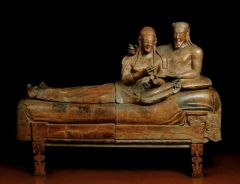
The Sarcophagus of the Spouses (Italian: Sarcofago degli Sposi) is a late 6th century BC Etruscan anthropoid sarcophagus, in the National Etruscan Museum of Villa Giulia, Rome. It is 1.14 m high by 1.9 m wide, and is made of terracotta which was once brightly painted.[1] It depicts a married couple reclining at a banquet together in the afterlife and was found in 19th century excavations at the necropolis of Cerveteri (ancient Caere). The portrayal of a married couple sharing a banqueting couch is distinctly an Etruscan style; in contrast, Greek vases depicting banquet scenes reflect the custom that only men attended dinner parties.[1][2] |
|
|
Terracotta |
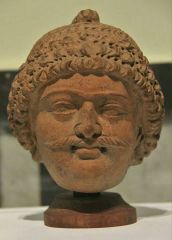
Terracotta, terra cotta or terra-cotta (pronounced [ˌtɛrraˈkɔtta]; Italian: "baked earth",[2] from the Latin terra cocta),[3] a type of earthenware, is a clay-based unglazed or glazed ceramic,[4] where the fired body is porous. Terracotta is the term normally used for sculpture made in earthenware, and also for various utilitarian uses including vessels (notably flower pots), water and waste water pipes, tiles, bricks, and surface embellishment in building construction.[5] The term is also used to refer to the natural, brownish orange color, of most terracotta, which varies considerably. |
|
|
tumuli |
A tumulus (plural tumuli) is a mound of earth and stones raised over a grave or graves. Tumuli also are known as barrows, burial mounds, or kurgans, and may be found throughout much of the world. A cairn, which is a mound of stones built for various purposes, might also originally have been a tumulus. |
|
|
necropolis |
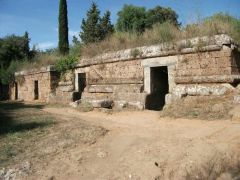
A necropolis is a large ancient cemetery with elaborate tomb monuments. The word is derived from the Ancient Greek νεκρόπολις nekropolis, literally meaning "city of the dead". |
|
|
Tufa |
2 : a porous rock formed as a deposit from springs or streams; specifically : travertine The Etruscans and the Romans used tufa a lot in early temples and in their tombs. But gradually they began to use travertine and marble instead. By the time of Julius Caesar, tufa was mainly used where it wouldn't show- in the foundations of buildings, or where it was going to be covered with slabs of marble or stucco. |
|
|
Capitoline Wolf |
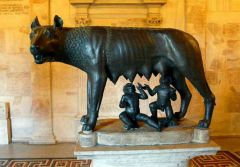
Musei Capitolini, Rome, Italy. The Capitoline Wolf (Italian: Lupa Capitolina) is a bronze sculpture of a she-wolf suckling twin human infants, inspired by the legend of the founding of Rome. |
|
|
Origins of Rome |
Aaaaaaa |
|
|
Romulus and Remus |

Romulus /ˈrɒmjᵿləs/ and Remus /ˈriːməs/ were the twin brothers and main characters of Rome's foundation myth. (The pronunciation in English is different from the Latin original Rōmulus and Rĕmus). According to Roman tradition, of which Livy's account is now the earliest to survive in full, their mother was Rhea Silvia, daughter of Numitor, king of Alba Longa. Before their conception, Numitor's brother Amulius seized power, killed Numitor's male heirs and forced Rhea Silvia to become a Vestal Virgin, sworn to chastity. Rhea Silvia conceived the twins by the god Mars. Once the twins were born, Amulius had them abandoned to die in the Tiber river. They were saved by a series of miraculous interventions: the river carried them to safety, a she-wolf found and suckled them, and a woodpecker fed them. A shepherd and his wife found them and fostered them to manhood as simple shepherds. The twins, still ignorant of their true origins, proved to be natural leaders. Each acquired many followers. When they discovered the truth of their birth, they killed Amulius and restored Numitor to his throne. Rather than wait to inherit Alba Longa, they chose to found a new city. |
|
|
Aule Metele |
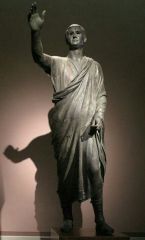
Aule Metele, Latin: Aulus Metellus; also known as The Orator, Italian: L'Arringatore, is a bronze sculpture 179 cm high.[1] It is a Romano-Etruscan work from the late second century or early first century BCE in the Roman style and depicts an Etruscan man, Aule Metele, wearing a short Roman toga and footwear. His right arm is raised to indicate that he is an orator addressing the public.[2]The retrograde inscription is in the Etruscan alphabet reads: : “auleśi meteliś ve[luś] vesial clenśi / cen flereś tece sanśl tenine / tu θineś χisvlicś” (“To (or from) Auli Meteli, the son of Vel and Vesi, Tenine (?) set up this statue as a votive offering to Sans, by deliberation of the people”) |

